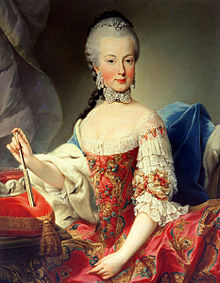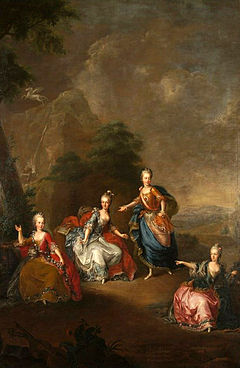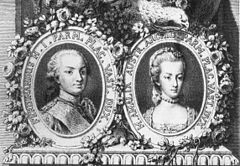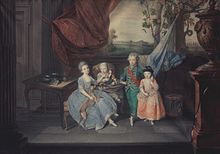- Archduchess Maria Amalia of Austria
-
Maria Amalia Duchess consort of Parma, Piacenza and Guastalla 
Maria Amalia by Martin van Meytens Tenure 19 July 1769 – 9 October 1802 Spouse Ferdinand, Duke of Parma Issue Princess Caroline of Parma
Louis of Etruria
Princess Maria Antonia of ParmaFull name Maria Amalia Josepha Johanna Antonia House House of Habsburg-Lorraine Father Francis I, Holy Roman Emperor Mother Maria Theresa of Austria Born 26 February 1746
Hofburg Imperial Palace, Vienna, AustriaDied 18 June 1804 (aged 58)
Prague Castle, Prague, modern day Czech RepublicMaria Amalia of Austria (26 February 1746 – 18 June 1804) was the Duchess of Parma, Piacenza and Guastalla by marriage. Maria Amalia was a daughter of Empress Maria Theresa and Emperor Francis I. She was thus younger sister to Joseph II, Holy Roman Emperor and older sister to Leopold II, Holy Roman Emperor, Maria Carolina, Queen of Naples and Marie Antoinette, Queen of France.
Contents
Archduchess of Austria
She was the eighth child of Maria Theresa of Austria and Emperor Francis Stephen. Born at the Hofburg Imperial Palace, she was raised in the Habsburg Viennese court.
One of her paintings, St. Therese and the child Jesus, still exists today in a private collection.
Marriage
Against her will, Amalia was married to Ferdinand of Parma (1751–1802). The marriage was supported by the future Holy Roman Emperor Joseph II, whose first beloved wife had been Ferdinand's sister, Princess Isabella of Parma. The Archduchess's marriage to the Duke of Parma was part of a complicated series of contracts that married off Maria Theresa's daughters to the King of Naples and Sicily and the Dauphin of France. All three sons-in-law were members of the House of Bourbon.
She left Austria on 1 July 1769, accompanied by her brother, Joseph II, and married Ferdinand on 19 July, at the Ducal Palace of Colorno. Two years after her arrival in Parma, Maria Amalia secured the dismissal of Du Tillot, her husband's minister, and replaced him with a Spanish appointee, Jose del Llano, who was highly recommended by Charles III of Spain. Duke Ferdinand also did not like Du Tillot and the two already had strained relations even before his wife reached Parma. A letter of Louis XV to his grandson dated May 1769 attests to this, wherein he counseled his grandson not to despise the minister who served his parents well; moreover, there was no one to replace him, said the French king.
Amalia would remain largely estranged from her mother, except for a brief reconciliation in 1773 when her son was born, despite the latter's repeated efforts at reconciliation. The duchess resisted her mother's efforts to control her from afar. When her sister Archduchess Marie Christine, known to the family as Marie or Mimi, visited Parma in 1775, she reported to their mother that Amalia lost much of her beauty and glamour and was also less gay and discriminating. Maria Theresa commissioned a portrait of her grandchildren in Parma by Johann Zoffany.
Maria Amalia was in touch with her sisters, Queen Marie Antoinette of France and Queen Marie Caroline of Naples and Sicily for most of their married lives. The three sisters exchanged letters, portraits and gifts. In fact, one of Marie Antoinette's last letters during her imprisonment was secretly written to her sister Maria Amalia.
When Napoleon Bonaparte invaded Italy and her husband died, Maria Amalia was appointed Head of the Regency Council in Parma by the dying Ferdinand but the regency lasted only a few days. On 22 October 1802 the French expelled her from Parma and she established her residence in Prague, particularly at Prague Castle, where she died in 1804. Her body was interred at the royal crypt of the St. Vitus Cathedral in Prague while her heart was taken to Vienna and placed inside an urn (number 33) at the family's Herzgruft (heart crypt).
Issue
She and Ferdinand had nine children:
- Princess Caroline of Parma (22 November 1770 – 1 March 1804). Married Prince Maximilian of Saxony and was the mother of King Frederick Augustus II and King Johann I of Saxony.
- King Louis I of Etruria (5 July 1773 – 27 May 1803). The first of only two kings of Etruria. Married his first cousin, Maria Louisa of Spain.
- Princess Maria Antonia of Parma (28 November 1774 – 20 February 1841), joined the religious order in 1802 and became an Ursuline abbess.
- Princess Charlotte Maria of Parma (7 September 1777 – 5 April 1813), joined the Dominican order in 1797 and became a prioress
- Prince Philip Maria of Parma (22 March 1783 – 2 July 1786).
- Princess Antonia Louise of Parma (21 October 1784), died in infancy.
- Princess Maria Luisa (Aloysia) of Parma (17 April 1787 – 22 November 1789).
- Stillborn Daughter, twin (21 May 1789)
- Stillborn Son, twin (21 May 1789)
Ancestry
Titles, styles, honours and arms
Titles and styles
- 26 February 1746 – 19 July 1769 Her Royal Highness Archduchess Maria Amalia of Austria, Princess of Hungry etc.
- 19 July 1769 – 9 October 1802 Her Royal Highness the Duchess of Parma
- 9 October 1802 – 18 June 1804 Her Royal Highness the Dowager Duchess of Parma
External links
 Media related to Maria Amalia of Austria at Wikimedia CommonsArchduchess Maria Amalia of AustriaHouse of Habsburg-LorraineBorn: Feb 26 1746 Died: Jun 18 1804
Media related to Maria Amalia of Austria at Wikimedia CommonsArchduchess Maria Amalia of AustriaHouse of Habsburg-LorraineBorn: Feb 26 1746 Died: Jun 18 1804Spanish royalty Preceded by
Princess Louise Élisabeth of FranceDuchess consort of Parma
19 July 1769 – 9 October 1802Succeeded by
Princess Maria Teresa of SavoyAustrian archduchesses by birth 1st generation none2nd generation Archduchess Helena · Kunigunde, Duchess of Bavaria3rd generation 4th generation Eleanor, Queen of France* · Isabella, Queen of Denmark and Norway* · Maria, Queen of Hungary* · Catherine, Queen of Portugal*5th generation Elisabeth, Queen of Poland · Maria, Holy Roman Empress* · Anna, Duchess of Bavaria · Archduchess Isabella* · Maria, Duchess of Jülich-Cleves-Berg · Archduchess Magdalena · Catherine, Queen of Poland · Eleanor, Duchess of Mantua · Archduchess Margaret · Joan, Princess of Portugal* · Barbara, Duchess of Ferrara · Archduchess Ursula · Archduchess Helena · Joanna, Grand Duchess of Tuscany6th generation Anna, Queen of Spain · Elisabeth, Queen of France · Archduchess Maria · Archduchess Maria · Isabella Clara Eugenia, Co-sovereign of the Habsburg Hetherlands* · Archduchess Margaret · Catherine Michelle, Duchess of Savoy* · Archduchess Eleanor · Archduchess Maria* · Archduchess Martha · Archduchess Anna Eleanor · Archduchess Maria · Anna, Holy Roman Empress · Anna, Queen of Poland · Maria Christina, Princess of Transilvania · Archduchess Catherine Renata · Archduchess Elisabeth · Archduchess Gregoria Maximiliana · Archduchess Eleanor · Margaret, Queen of Spain · Constance, Queen of Poland · Maria Maddalena, Grand Duchess of Tuscany7th generation Archduchess Christine · Anna, Queen of France* · Archduchess Maria · Maria Anna, Holy Roman Empress* · Archduchess Anna Mauritia · Maria Anna, Electress of Bavaria · Archduchess Margarita Francisca* · Cecilia Renata, Queen of Poland · Archduchess Maria Eleanor · Isabella Clara, Duchess of Mantua · Maria Leopoldine, Holy Roman Empress8th generation Archduchess Maria Margarita* · Archduchess Margarita Maria Catalina* · Archduchess Maria Eugenia* · Archduchess Isabella Maria Teresa* · Maria Anna, Queen of Spain · Archduchess Maria Anna Antonia* · Maria Theresa, Queen of France* · Archduchess Maria · Margarita Teresa, Holy Roman Empress* · Archduchess Theresia Maria Josepha · Eleanor, Queen of Poland, Duchess of Lorraine · Claudia Felicitas, Holy Roman Empress · Maria Anna Josepha, Electoral Princess of the Palatinate · Archduchess Maria Ambrosia de la Concepción* · Archduchess Maria Magdalena9th generation Maria Antonia, Electress of Bavaria · Archduchess Maria Anna Antonia · Archduchess Anna Maria · Archduchess Maria Josepha · Archduchess Christina · Archduchess Maria Elisabeth · Maria Anna, Queen of Portugal · Archduchess Maria Theresa · Archduchess Maria Josepha · Archduchess Maria Magdalena · Archduchess Maria Margaretha10th generation Maria Josepha, Queen of Poland · Maria Amalia, Holy Roman Empress · Maria Theresa · Maria Anna, Princess Charles Alexander of Lorraine · Archduchess Maria Amalia11th generation Archduchess Maria Elisabeth** · Archduchess Maria Anna** · Archduchess Maria Carolina** · Maria Christina, Duchess of Teschen** · Archduchess Maria Elisabeth** · Maria Amalia, Duchess of Parma** · Archduchess Maria Carolina** · Archduchess Johanna** · Archduchess Maria Josepha** · Maria Carolina, Queen of Naples** · Marie Antonia, Queen of France**12th generation Archduchess Maria Theresa · Archduchess Marie Christine · Maria Theresia, Queen of Saxony** · Archduchess Maria Anna** · Maria Theresa, Queen of Sardinia*** · Archduchess Maria Josepha*** · Maria Leopoldine, Electress of Bavaria*** · Maria Clementina, Duchess of Calabria** · Archduchess Maria Amalia** · Archduchess Maria Antonia*** · Maria Ludovika, Empress of Austria***13th generation Archduchess Ludovika Elisabeth · Marie Louise, Empress of the French · Archduchess Carolina Ferdinande** · Archduchess Maria Caroline · Archduchess Caroline Ludovika · Maria Leopoldina, Empress of Brazil · Clementina, Princess of Salerno · Archduchess Maria Luisa** · Archduchess Alexandrine · Maria Theresa, Queen of Sardinia** · Marie Caroline, Crown Princess of Saxony · Archduchess Maria Anna · Archduchess Amalia Theresa · Maria Theresa, Queen of the Two Sicilies · Maria Theresa, Countess of Chambord*** · Archduchess Hermine · Archduchess Franziska · Archduchess Maria Caroline · Adelaide, Queen of Sardinia · Maria Beatrix, Countess of Montizón*** · Archduchess Maria Caroline · Archduchess Elisabeth Franziska · Marie Henriette, Queen of the Belgians14th generation Archduchess Maria Anna · Archduchess Maria Carolina** · Auguste Ferdinande, Princess Luitpold of Bavaria** · Archduchess Maria Maximiliana** · Maria Isabella, Countess of Trapani** · Archduchess Maria Theresia** · Archduchess Maria Cristina** · Archduchess Maria Anna** · Maria Theresa, Duchess Philipp of Württemberg · Archduchess Mathilda · Maria Christina, Queen of Spain · Archduchess Maria Eleonora · Archduchess Elisabeth · Maria Dorothea, Duchess of Orléans · Margaretha Klementine, Princess of Thurn and Taxis · Archduchess Elisabeth Henriette · Archduchess Klotilde · Maria Theresa, Queen of Bavaria***15th generation Archduchess Sophie · Gisela, Princess Leopold of Bavaria · Archduchess Marie Valerie · Margarete Sophie, Duchess of Württemberg · Archduchess Maria Annunziata · Elisabeth, Princess Aloys of Liechtenstein · Archduchess Maria Antonietta** · Luise, Crown Princess of Saxony** · Anna, Princess of Hohenlohe-Bartenstein** · Archduchess Margareta** · Archduchess Germana** · Archduchess Agnes** · Archduchess Maria Theresa** · Karoline Marie, Princess Leopold of Saxe-Coburg and Gotha** · Archduchess Maria Antonietta** · Maria Immaculata, Duchess of Württemberg** · Archduchess Henriette** · Maria Christina, Princess Emmanuel of Salm-Salm · Maria Anna, Princess Elias of Bourbon Parma · Maria Henrietta, Princess of Hohenlohe-Waldenburg-Schillingsfürst · Archduchess Natalie · Archduchess Stephanie · Archduchess Gabrielle · Isabella, Princess Georg of Bavaria · Alice, Baroness Waldbott of Bassenheim · Archduchess Eleonora, Mrs. Alfons von Kloss · Renata, Princess Hieronymus Radziwill · Mechthildis, Princess Olgierd Czartoryski · Archduchess Gisele · Archduchess Sophie · Archduchess Magdalena16th generation Elisabeth Marie, Princess of Windisch-Graetz · Helena, Duchess Philipp of Württemberg** · Rosa, Duchess of Württemberg** · Archduchess Dolores** · Maria Inmaculada, Nobile Inigo Neri Sereneri** · Margarita, Marchioness Taliani di Marchio** · Princess Maria Antonia, Mrs. Luis Pérez** · Archduchess Assunta, Mrs. Joseph Hopfinger** · Elisabeth, Countess of Waldburg-Zeil** · Hedwig, Countess of Stolberg-Stolberg** · Gertrud, Countess of Waldburg-Zeil-Trauchburg** · Archduchess Maria Elisabeth** · Archduchess Agnes** · Archduchess Margarethe, Mrs. Alexander Cech · Ilona, Duchess of Mecklenburg · Archduchess Anna Theresia · Archduchess Maria Kynga, Mrs. Joachim Krist17th generation Archduchess Adelheid · Charlotte, Duchess of Mecklenburg · Elisabeth, Princess Heinrich of Liechtenstein · Elisabeth, Edle Hubert von Braun** · Alice, Baroness Vittorio Manno** · Marie Antoinette, Baroness of Proff in Irnich** · Archduchess Marie Christine** · Archduchess Walburga, Mrs. Carlos Tasso** · Archduchess Verena** · Archduchess Katharina, Mrs. Roland Huber** · Agnes, Baroness Peter of Fürstenberg** · Maria Ileana, Countess Adam Kottulinski** · Alexandra, Baroness Viktor of Baillou** · Maria Magdalena, Baroness of Holzhausen** · Archduchess Elisabeth, Mrs. Friedrich Sandhofer** · Agnes, Princess Karl Alfred of Liechtenstein** · Archduchess Maria Margaretha** · Archduchess Ludovica** · Archduchess Allix** · Josepha, Countess Clemens of Waldstein-Wartenberg** · Valerie, Margravine of Baden** · Alberta, Baroness Alexander of Kottwitz-Erdödy** · Theresa, Princess Rasso of Bavaria** · Maria Inmakulata, Countess Reinhart of Hoensbroech** · Archduchess Monika, Mrs. Charles de Rambures · Archduchess Marie Christine, Mrs. Raymond van der Meide · Archduchess Maria, Mrs. Wilhelm de Witt · Margherita, Countess Benedikt of Piatti18th generation Andrea, Hereditary Countess of Neipperg · Monika, Duchess of Maqueda · Michaela, Countess Hubertus of Kageneck · Archduchess Gabriela, Mrs. Christian Meister · Walburga, Countess Archibald Douglas · Maria Beatrix, Countess Riprand of Arco-Zinneberg*** · Isabella, Countess Andrea Czarnocki-Lucheschi*** · Maria del Pilar, Edle Vollrad-Joachim von Poschinger · Kinga, Baroness Wolfgang of Erffa · Archduchess Marie Adelheid, Mrs. Jaime Corcuerra · Archduchess Viridis, Mrs. Karl Dunning-Gribble · Archduchess Alexandra, Mrs. Héctor Riesle · Maria Constanza, Princess of Auersperg-Trautson · Maria Anna, Princess Peter Galitzine · Catharina, Countess Maximiliano Secco d'Aragona · Archduchess Elisabeth, Mrs. James Litchfield · Sophie, Princess of Windisch-Grätz · Archduchess Marie Christine, Mrs. Clemens Guggenberg · Archduchess Marie Bernadette, Mrs. Rupert Wolff** · Archduchess Katharina, Mrs. Niall Brooks** · Archduchess Alicia** · Archduchess Maria Christina** · Archduchess Margaretha, Mrs. Andreas Baumgartner** · Archduchess Marie Valerie, Mrs. Martin Josef Wagner** · Archduchess Hedwig** · Archduchess Veronika** · Archduchess Johanna · Archduchess Elisabeth · Archduchess Celina · Archduchess Maria Floriana · Archduchess Sofía · Archduchess Anna Carolina · Archduchess Theresa · Archduchess Sophie · Archduchess Ladislaya19th generation Archduchess Eleonore · Archduchess Gloria · Archduchess Sophie · Archduchess Hilda · Archduchess Maria Laura*** · Archduchess Luisa Maria*** · Archduchess Laetitia Maria*** · Archduchess Sophia · Archduchess Maria Theresa · Archduchess Margherite · Archduchess Priscilla · Archduchess Marie des Neiges · Marie Christine, Countess Rodolphe of Limburg-Stirum · Archduchess Gabriella · Archduchess Antonia · Archduchess Isabelle · Archduchess Carlotta · Archduchess Paulina · Archduchess Lara · Archduchess Katharina · Archduchess Tatyana** · Archduchess Anabella** · Archduchess Tara** · Archduchess Amaya20th generation Archduchess Zita · Archduchess Anežka*also an infanta of Spain
**also a princess of Tuscany
***also a princess of Modena2nd Generation Eleonora, Duchess of Mantua · Princess Rommola · Princess Anna · Princess Isabella · Princess Lucrezia · Marie, Queen of France · Princess Eleonora · Princess Caterina · Princess Maria Maddalena · Claudia, Archduchess of Further Austria3rd Generation Princess Maria Cristina · Margherita, Duchess of Parma · Anna, Archduchess of Further Austria · Catherine, Duchess of Mantua and Montferrat4th Generation none5th Generation 6th Generation none7th Generation Princess Maria Anna* · Maria Christina, Duchess of Teschen* · Princess Maria Elisabeth* · Maria Amalia, Duchess of Parma* · Princess Maria Johanna Gabriela* · Princess Maria Josepha* · Maria Carolina, Queen of Naples and Sicily* · Maria Antonia, Queen of France*8th Generation Maria Theresia, Queen of Saxony* · Princess Maria Anna* · Princess Maria Amalia* · Maria Clementina, Duchess of Calabria*9th Generation 10th Generation Princess Maria Carolina* · Auguste Ferdinande, Princess Luitpold of Bavaria* · Princess Maria Maximiliana* · Maria Isabella, Countess of Trapani* · Princess Maria Theresia* · Princess Maria Cristina* · Princess Maria Anna* · Maria Luisa, Princess of Ysenburg and Büdingen*11th Generation Princess Maria Antonietta* · Luise, Crown Princess of Saxony* · Anna, Princess of Hohenlohe-Bartenstein* · Princess Margareta* · Princess Germana* · Princess Agnes* · Maria Theresa, Archduchess Charles Stephen of Austria* · Karoline Marie, Princess Leopold of Saxe-Coburg and Gotha* · Princess Maria Antonietta* · Maria Immakulata, Duchess Robert of Württemberg* · Princess Henriette*12th Generation Helena, Duchess Philipp of Württemberg* · Rosa, Duchess of Württemberg* · Princess Dolores* · Maria Immaculada, Nobile Inigo Neri Sereneri* · Margarita, Marchioness Taliani di Marchio* · Princess Maria Antonia, Mrs. Luis Pérez* · Princess Assunta, Mrs. Joseph Hopfinger* · Elisabeth, Countess of Waldburg-Zeil-Hohenems* · Hedwig, Countess of Stolberg-Stolberg* · Gertrud, Countess of Waldburg-Zeil-Trauchburg* · Princess Maria Elisabeth* · Princess Agnes*13th Generation Elisabeth, Edle Hubert von Braun* · Alice, Baroness Vittorio Manno* · Marie Antoinette, Freifrau von Proff zu Irnich* · Princess Marie Christine* · Princess Walburga, Mrs. Carlos Tasso* · Princess Verena* · Princess Katharina, Mrs. Roland Huber* · Agnes, Freifrau Peter von Fürstenberg* · Maria Ileana, Countess Adam Kottulinski* · Alexandra, Freifrau Viktor von Baillou* · Maria Magdalena, Freifrau von Holzhausen* · Princess Elisabeth, Mrs. Friedrich Sandhofer* · Agnes, Princess Karl Alfred of Liechtenstein* · Princess Maria Margaretha* · Princess Ludovica* · Princess Allix* · Josepha, Countess Clemens of Waldstein-Wartenberg* · Valerie, Margravine of Baden* · Alberta, Freifrau Alexander von Kottwitz-Erdödy* · Theresa, Princess Rasso of Bavaria* · Maria Inmakulata, Countess Reinhart of Hoensbroech*14th Generation Princess Marie Bernadette, Mrs. Rupert Wolff* · Princess Katharina, Mrs. Niall Brooks* · Princess Alicia* · Princess Maria Christina* · Princess Margaretha, Mrs. Andreas Baumgartner* · Princess Marie Valerie, Mrs. Martin Josef Wagner* · Princess Hedwig* · Princess Veronika*15th Generation Princess Tatyana* · Princess Anabella* · Princess Tara** also an archduchess of Austria
^did not have a royal or noble birth2nd Generation 3rd Generation Margherita Aldobrandini*4th Generation 5th Generation none6th Generation 7th Generation none8th Generation none9th Generation Archduchess Maria Amalia of Austria10th Generation 11th Generation 12th Generation Louise Marie Thérèse d'Artois13th Generation Princess Maria Pia of Bourbon-Two Sicilies · Infanta Maria Antonia of Portugal · Princess Maria Immacolata of Bourbon-Two Sicilies · Infanta Adelgundes of Portgual14th Generation Archduchess Maria Anna of Austria · Hedwig de La Rochefoucauld · Madeleine de Bourbon* · Charlotte, Grand Duchess of Luxembourg · Princess Margaret of Denmark · Princess Maria Francesca of Savoy · Princess Margaret of Thurn and Taxis · Princess Joséphine-Charlotte of Belgium^! · Joan Douglas Dillon*^!15th Generation Princess Irene of the Netherlands · Countess Brigitte of Holstein-Ledreborg · Princess Yolande of Broglie-Revel · Princess Maria Pia of Savoy16th Generation Countess Lydia of Holstein-Ledreborg · Constance de Ravinel**did not have a royal or noble title by birth
^also princess of Luxembourg by marriage
!also princess of Nassau by marriageInfantas of Spain by marriage 1st generation 2nd generation none3rd generation 4th generation none5th generation none6th generation none7th generation Louise Élisabeth d'Orléans · Infanta Barbara of Portugal · Princess Maria Amalia of Saxony · Princess Louise Élisabeth of France8th generation Princess Maria Luisa of Parma · Infanta Mariana Victoria of Portugal · Infanta Maria Amalia of Spain* · Archduchess Maria Amalia of Austria9th generation Princess Maria Antonia of Naples and Sicily · Infanta Maria Francisca of Portugal · Infanta Teresa of Portugal, Princess of Beira · Princess Luisa Carlotta of Naples and Sicily10th generation Princess Maria Carolina of the Two Sicilies · Archduchess Maria Beatrix of Austria-Este · Isabella II of Spain* · Infanta Maria Cristina of Spain* · Princess Maria Amalia of the Two Sicilies · Princess Maria Teresa of Savoy11th generation Infanta Eulalia of Spain* · Princess Margherita of Parma · Princess Louise Marie Thérèse of France · Berthe de Rohan · Infanta Maria das Neves of Portugal12th generation Princess Louise of Orléans · Princess Beatrice of Saxe-Coburg and Gotha · Princess Maria Pia of Bourbon-Two Sicilies · Infanta Maria Antonia of Portugal13th generation Princess Mercedes of the Two Sicilies · Princess Alicia of Parma14th generation 15th generation *also an Infanta in her own right
**did not have a royal or noble title by birth but was admitted as InfantaGerolama Orsini (1545-1547) · Margaret of Austria (1547-1586) · Margherita Aldobrandini (1600-1620) · Margherita de' Medici (1628-1646) · Princess Margherita Violante of Savoy (1660-1663) · Isabella d'Este (1664-1666) · Maria d'Este (1668-1686) · Countess Palatine Dorothea Sophie of Neuburg (1695-1727) · Enrichetta d'Este (1727-1731) · Elisabeth Christine of Brunswick-Wolfenbüttel (1735-1740) · Princess Louise Élisabeth of France (1748-1759) · Archduchess Maria Amalia of Austria (1769-1802) · Princess Maria Teresa of Savoy (1847-1848) · Louise Marie Thérèse d'Artois (1848-1854) · Princess Maria Pia of the Two Sicilies* (1869-1882) · Infanta Maria Antonia of Portugal* (1884-1907) · Madeleine de Bourbon* (1974-1977) · Princess Irene of the Netherlands* (1977-1981) · Annemarie Gualthérie van Weezel* (2010-)- denotes titular Duchess
Categories:- 1746 births
- 1804 deaths
- Duchesses of Piacenza
- House of Bourbon-Parma
- House of Habsburg-Lorraine
- Archduchesses of Austria
- Princesses of Bourbon-Parma
- Bohemian princesses
- Hungarian princesses
- Tuscan princesses
- Duchesses of Parma
- Dames of the Order of the Starry Cross
Wikimedia Foundation. 2010.




